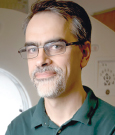A University of California, Davis research team has been awarded $15.5 million to build the world’s first total-body positron emission tomography (PET) scanner, which could fundamentally change the way cancers are tracked and treated.
The Transformative Research Award, part of the National Institutes of Health High-Risk, High-Reward Program, supports bold and untested ideas that have the potential to be paradigm-shifting. This award is one of eight given in the transformative research category in 2015. The 5-year grant, administered by the National Cancer Institute, will fund the EXPLORER project, led by Simon Cherry, PhD, Distinguished Professor of Biomedical Engineering, and Ramsey Badawi, PhD, Professor of Radiology.
Limitations of Current Scanning
PET scans are widely used to diagnose and track a variety of diseases, including cancer, because they show how organs and tissues are functioning in the body (in contrast to magnetic resonance imaging or computed tomography scans, which mostly show anatomy). The EXPLORER project would address shortcomings of the current scanning technology, which requires more time and exposes the patient to more radiation because scans are done in 20-cm segments.
“The vision of the EXPLORER project is to solve two fundamental limitations of PET as it is currently practiced,” said Dr. Cherry, who is Codirector of the Biomedical Technology Program at the UC Davis Comprehensive Cancer Center. “The first is to allow us to see the entire body all at once. The second huge advantage is that we’re collecting almost the entire available signal, which means we can acquire the images much faster or at a much lower radiation dose. That’s going to have some profound implications for how we use PET scanning in medicine and medical science.”
Huge Advantages
Drs. Cherry and Badawi predict that by seeing the entire body simultaneously, their scanner could drop the radiation dose by a factor of 40 or decrease scanning time from 20 minutes to just 30 seconds. A quicker scan also could reduce the incidence of images blurred by patient movement.
The technology would have implications in diagnostics, treatment, and drug development. With whole-body PET, physicians could diagnose a disease and then follow its trajectory in a way never before possible, affecting how patients are treated. This approach reflects the current trend in medicine to develop systems-based treatments and more individualized care.
Additionally, pharmaceutical companies could use the scanner to show how drugs and compounds are transported through the body and determine whether a drug is targeting the disease or whether it goes to other organs.
“There are many questions that we couldn’t possibly ask before—and now we will be able to ask them,” Dr. Badawi said. “This is not just a big instrumentation grant. It’s going to give us a tool that will allow us to see things we’ve never seen before.”
After additional studies, the researchers are hoping their technology will lead to new discoveries of the human body and even launch a whole diagnostic field.
The project is a consortium led by UC Davis that also involves University of Pennsylvania and Lawrence Berkeley National Laboratory researchers.
Fundamental research for the EXPLORER project was made possible by the UC Davis Research Investments in the Sciences and Engineering program, designed to launch large-scale interdisciplinary research activity at the university. Additional support was provided by the National Cancer Institute. ■


